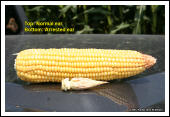Published 8 July 2008 (rev. 28 July 2008)
URL: http://www.kingcorn.org/news/articles.08/ArrestedEarsCaution-0708.html

Possible Potential for Arrested Ear Development
R.L. (Bob) Nielsen
Agronomy Dept., Purdue Univ.
West Lafayette, IN 47907-2054
Email address: rnielsen
at purdue.edu
![]() he
prospects of selling $7 corn, or $8 corn, or $10 corn this fall increases
the desire of any corn grower to do whatever it takes to maximize yield per
acre to capitalize on these historic grain prices. Growers who have lost acres
of corn to floodwaters or ponding are also anxious to maximize grain yield
on their remaining acres as well as maximize the yield potential of corn that
survived the numerous events of excessive rainfall.
he
prospects of selling $7 corn, or $8 corn, or $10 corn this fall increases
the desire of any corn grower to do whatever it takes to maximize yield per
acre to capitalize on these historic grain prices. Growers who have lost acres
of corn to floodwaters or ponding are also anxious to maximize grain yield
on their remaining acres as well as maximize the yield potential of corn that
survived the numerous events of excessive rainfall.
Towards this end, the use of post-emergence applications of foliar herbicides, fungicides, insecticides, and fertilizers is more common today than ever before. In particular, some of these applications occur during the 1 to 2 week period preceding the onset of pollination. This time period coincides with the last stages of ear size determination and early stages of silk elongation by the developing ovules (Nielsen, 2007b).
Click on image to open a larger version. To close popup window, click on larger image.
 Some
of the regulars down at the Chat 'n Chew Cafe remember the problems with arrested
ear development that were reported in 2007 in some fields treated with certain
foliar fungicides, insecticides, and/or fertilizers. I described some of the
symptoms in an article published last September (Nielsen,
2007c), but most could be described simply as a total or near total arrest
of further ear development following the applications of these chemicals.
The arrested ear symptoms in the affected fields were different from another
form of arrested ear development that is referred to as "Blunt Ear Syndrome"
(Nielsen,
2007a).
Some
of the regulars down at the Chat 'n Chew Cafe remember the problems with arrested
ear development that were reported in 2007 in some fields treated with certain
foliar fungicides, insecticides, and/or fertilizers. I described some of the
symptoms in an article published last September (Nielsen,
2007c), but most could be described simply as a total or near total arrest
of further ear development following the applications of these chemicals.
The arrested ear symptoms in the affected fields were different from another
form of arrested ear development that is referred to as "Blunt Ear Syndrome"
(Nielsen,
2007a).
The primary common thread that linked all of the affected fields was the timing of a chemical application during the 1 to 2 week period preceding the onset of pollination. Applications of foliar fungicides captured most of the attention. Most of the reported fields were indeed treated with foliar fungicide, but many were treated with a combination of foliar fungicide plus insecticide, and some were treated with foliar fungicide plus fertilizer. Anectdotal reports suggested the worst of the arrested ears occurred in fields where the chemicals were applied with high-clearance spray applicators versus aerial applications.
To my knowledge, no one has conclusively diagnosed the specific causal factor that led to the arrested ear development in the affected fields last year. None of the published fungicide labels list cautions about the timing of application relative to crop growth stage (BASF, 2008b; Bayer CropScience, 2008; Syngenta, 2008).
Update: As of 10 July, the manufacturer of one fungicide, has published a technical information bulletin on their Web site (BASF, 2008a) that includes a table that cautions against using adjuvants with their product prior to full tassel emergence and also states that the "optimal application timing" of their product is from VT (full tassel emergence) through R2 (kernel blister stage) or "prior to the onset of disease." A supplemental label for aerial applications of Headline was also approved by the EPA on 18 July that restricts the use of adjuvants for applications made prior to tasseling (BASF, 2008c)
I simply offer this fearmongering opinion that growers ought to be cautious about the application of any foliar pesticides or fertilizers during this important phenological period leading up to pollination unless there is a demonstrated need to do so.
Related References
BASF Corporation. 2008a. Headline Fungicide Corn Technical Information Bulletin. [On-line]. Available at http://www.agproducts.basf.com/products/Headline-Fungicide/Headline_Corn_TIB.pdf. [URL accessed 7/11/08].
BASF Corporation. 2008b. Headline fungicide label. [On-line]. Available at http://www.cdms.net/ldat/ld62L047.pdf. [URL accessed 7/8/08].
BASF Corporation. 2008c. Headline fungicide supplemental label for aerial applications to corn. [On-line]. Available at http://www.cdms.net/ldat/ld62L050.pdf. [URL accessed 7/28/08].
Bayer CropScience. 2008. Stratego fungicide label. [On-line]. Available at http://www.agrian.com/pdfs/Stratego_Fungicide_(011008)_Label0.pdf. [URL accessed 7/8/08].
Bradley, Carl. 2008. Making Profitable Fungicide Applications in Corn. The Bulletin. Univ of Illinois Extension. [On-line]. Available at http://www.ipm.uiuc.edu/bulletin/article.php?id=976. [URL accessed 7/8/08].
Loux, Mark M., Anthony F. Dobbels, Jeff M. Stachler, William G. Johnson, Glenn R.W. Nice, and Thomas T. Bauman. 2008. Rain Intervals, Spray Additives, and Maximum Crop Size for Postemergence Corn Herbicides. in "Weed Control Guide for Ohio and Indiana". Purdue Univ. and Ohio State Univ. Extension. [On-line]. Available at http://www.btny.purdue.edu/Pubs/WS/WS-16/CornRainFast.pdf. [URL accessed 7/8/08].
Nielsen, R.L. (Bob). 2007a. Blunt Ear Syndrome in Corn. Corny News Network, Purdue Univ. [On-line]. Available at http://www.kingcorn.org/news/articles.03/BeerCanEars-0812.html. [URL accessed 7/8/08].
Nielsen, R.L. (Bob). 2007b. Ear Size Determination in Corn. Corny News Network, Purdue Univ. [On-line]. Available at http://www.kingcorn.org/news/timeless/EarSize.html. [URL accessed 7/8/08].
Nielsen, R.L. (Bob). 2007c. Symptomology of Arrested Ear Development in Corn. Corny News Network, Purdue Univ. [On-line]. Available at http://www.kingcorn.org/news/articles.07/ArrestedEars-0904.html. [URL accessed 7/8/08].
Syngenta. 2008. Quilt fungicide label. [On-line]. Available at http://www.syngentacropprotection.com/pdf/labels/SCP1178AL6B0308.pdf. [URL accessed 7/8/08].

